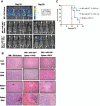Regulation of acute graft-versus-host disease by microRNA-155
- PMID: 22408260
- PMCID: PMC3367879
- DOI: 10.1182/blood-2011-10-387522
Regulation of acute graft-versus-host disease by microRNA-155
Abstract
Acute graft-versus-host disease (aGVHD) remains a major complication of allogeneic hematopoietic stem cell transplant (alloHSCT), underscoring the need to further elucidate its mechanisms and develop novel treatments. Based on recent observations that microRNA-155 (miR-155) is up-regulated during T-cell activation, we hypothesized that miR-155 is involved in the modulation of aGVHD. Here we show that miR-155 expression was up-regulated in T cells from mice developing aGVHD after alloHSCT. Mice receiving miR-155-deficient donor lymphocytes had markedly reduced lethal aGVHD, whereas lethal aGVHD developed rapidly in mice recipients of miR-155 overexpressing T cells. Blocking miR-155 expression using a synthetic anti-miR-155 after alloHSCT decreased aGVHD severity and prolonged survival in mice. Finally, miR-155 up-regulation was shown in specimens from patients with pathologic evidence of intestinal aGVHD. Altogether, our data indicate a role for miR-155 in the regulation of GVHD and point to miR-155 as a novel target for therapeutic intervention in this disease.
Figures







Similar articles
-
MicroRNA-155 Modulates Acute Graft-versus-Host Disease by Impacting T Cell Expansion, Migration, and Effector Function.J Immunol. 2018 Jun 15;200(12):4170-4179. doi: 10.4049/jimmunol.1701465. Epub 2018 May 2. J Immunol. 2018. PMID: 29720426 Free PMC article.
-
miR-181a Expression in Donor T Cells Modulates Graft-versus-Host Disease after Allogeneic Bone Marrow Transplantation.J Immunol. 2016 May 1;196(9):3927-34. doi: 10.4049/jimmunol.1502152. Epub 2016 Mar 23. J Immunol. 2016. PMID: 27009493
-
Endothelial microparticles delivering microRNA-155 into T lymphocytes are involved in the initiation of acute graft-versus-host disease following allogeneic hematopoietic stem cell transplantation.Oncotarget. 2017 Apr 4;8(14):23360-23375. doi: 10.18632/oncotarget.15579. Oncotarget. 2017. PMID: 28423578 Free PMC article.
-
Pathogenesis of acute graft-versus-host disease: from intestinal microbiota alterations to donor T cell activation.Br J Haematol. 2016 Oct;175(2):191-207. doi: 10.1111/bjh.14295. Epub 2016 Sep 13. Br J Haematol. 2016. PMID: 27619472 Review.
-
MicroRNA in T-Cell Development and T-Cell Mediated Acute Graft-Versus-Host Disease.Front Immunol. 2018 May 7;9:992. doi: 10.3389/fimmu.2018.00992. eCollection 2018. Front Immunol. 2018. PMID: 29867969 Free PMC article. Review.
Cited by
-
Extracellular Vesicles as Biomarkers of Acute Graft-vs.-Host Disease After Haploidentical Stem Cell Transplantation and Post-Transplant Cyclophosphamide.Front Immunol. 2022 Jan 25;12:816231. doi: 10.3389/fimmu.2021.816231. eCollection 2021. Front Immunol. 2022. PMID: 35145514 Free PMC article.
-
FOXP3 is a direct target of miR15a/16 in umbilical cord blood regulatory T cells.Bone Marrow Transplant. 2014 Jun;49(6):793-9. doi: 10.1038/bmt.2014.57. Epub 2014 Apr 7. Bone Marrow Transplant. 2014. PMID: 24710569 Free PMC article.
-
The Role of MicroRNAs in Myeloid Cells during Graft-versus-Host Disease.Front Immunol. 2018 Jan 23;9:4. doi: 10.3389/fimmu.2018.00004. eCollection 2018. Front Immunol. 2018. PMID: 29410665 Free PMC article. Review.
-
Discovery and validation of graft-versus-host disease biomarkers.Blood. 2013 Jan 24;121(4):585-94. doi: 10.1182/blood-2012-08-355990. Epub 2012 Nov 19. Blood. 2013. PMID: 23165480 Free PMC article. Review.
-
Seeking biomarkers for acute graft-versus-host disease: where we are and where we are heading?Biomark Res. 2019 Aug 7;7:17. doi: 10.1186/s40364-019-0167-x. eCollection 2019. Biomark Res. 2019. PMID: 31406575 Free PMC article. Review.
References
-
- Haasch D, Chen YW, Reilly RM, et al. T-cell activation induces a noncoding RNA transcript sensitive to inhibition by immunosuppressant drugs and encoded by the proto-oncogene, BIC. Cell Immunol. 2002;217(1):78–86. - PubMed
Publication types
MeSH terms
Substances
Grants and funding
LinkOut - more resources
Full Text Sources
Other Literature Sources
Molecular Biology Databases

